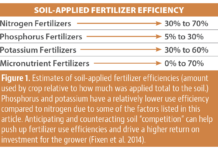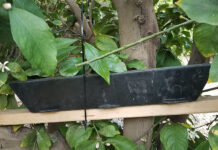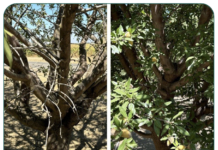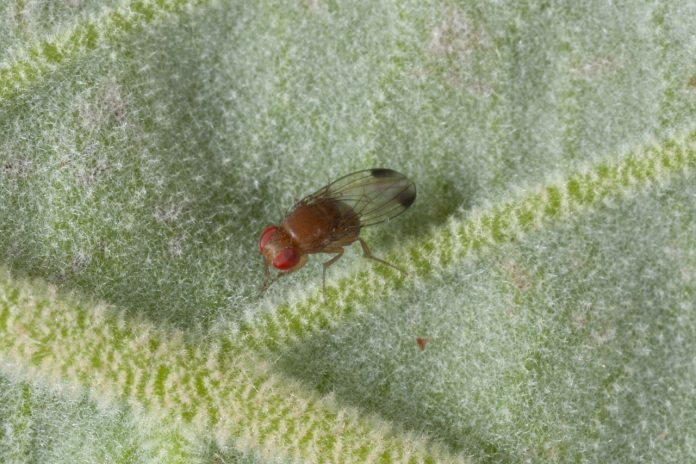
Spotted wing drosophila (SWD) is an invasive fruit fly species native to Asia. It was first detected in the U.S. in California in 2008 and has since spread to many parts of the Americas and Europe. SWD is a serious pest of cherry and soft-skinned fruits such as raspberry, blueberry, strawberry and blackberry. Unlike vinegar flies that attack overripe or damaged fruit, SWD females can lay their eggs in healthy, ripening cherry fruit using their serrated ovipositor. The larvae hatch and feed on the fruit, making it soft, discolored and unmarketable.
SWD has a relatively short life cycle with adults living for three to four weeks. One female can lay over 300 eggs that can hatch in two to three days, and the larvae complete their development in 7 to 10 days. The pupal stage lasts 5 to 10 days, after which the adult flies emerge. SWD can have multiple generations yearly, up to 10 to 12 in warm regions. This rapid reproduction, multiple generations and high fecundity make SWD a challenging pest in cherry and other soft fruit crops.
SWD management in California involves using synthetic insecticides multiple times a year when cherry fruits become susceptible from color development to harvest. Depending on variety and location, that period can vary from four to eight weeks. In recent years, studies have suggested a reduced susceptibility of SWD to commonly used insecticides in several crops across many states within the U.S. and Canada. In Michigan, researchers found reduced susceptibility to SWD flies exposed to malathion and spinetoram. In California, researchers found SWD populations in some strawberry and caneberry fields in the coastal area show resistance to pyrethroid, Spinosad and malathion. This resistance is believed to be due to the overuse of these insecticides, which has led to the selection of resistant SWD populations. In 2022, our preliminary study using a cherry orchard collected SWD indicated their reduced susceptibility to malathion, Spinosad and pyrethroid insecticide. We will continue to pursue confirmatory studies by testing wild flies from several California cherry orchards in the upcoming season.
Resistance to pesticides can also develop due to failure to rotate insecticides with different modes of action. Implementing integrated pest management (IPM) strategies that minimize the selection pressure on SWD populations is essential to address the issue of resistance in California berry crops.
Pest Monitoring
Integrating monitoring/sampling techniques with available control methods, such as cultural, physical and chemical, is vital for this pest’s long-term management.
Use sticky traps or baited traps to capture and monitor SWD populations. Place the traps in the cherry orchard and monitor them frequently to assess pest pressure in the orchard. SWD traps are commercially available from several vendors.
Assess the fruit susceptibility stage by carefully observing the orchard and detecting the susceptible stage of the fruit (i.e., color-break stage). Although SWD may be captured in the trap early, SWD can only damage ripening fruits. So, determining the right time to begin insecticide sprays helps control SWD effectively and may save an application or two.
Survey fruits for the early indicators of infestation by looking for signs of SWD infestation on the surface of the fruit. These signs include soft spots, bruising or holes in the fruit’s skin. It can be too late to protect crops, but if it’s an early stage of infestation, most of the fruits can still be protected.
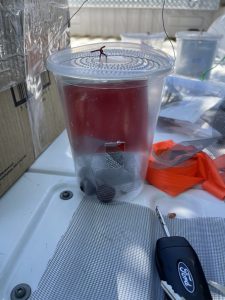
Management Options
Effective control measures often require a combination of cultural, physical and chemical methods.
Cultural Alternate host plants growing close to the crop can significantly increase the risk of SWD infestation. Clear out wild hosts if they are present adjacent to the cherry orchard.
Make the orchard less conducive for the SWD population. A dense canopy with poor light penetration creates high humidity conditions in the orchard, especially in the lower canopy, and that environment is more conducive for SWD flies. So, practices such as pruning improve air circulation and light penetration.
Keep the orchard clean and free of fallen fruit during the season and postharvest as these trash fruits can serve as breeding sites for SWD. Additionally, prompt cooling and storage of fruit can help prevent SWD infestations from developing during storage.
Chemical Apply insecticides when SWD populations reach a certain threshold. Insecticides should be applied when the fruit begins to ripen.One of the primary ways to manage SWD resistance is to rotate the use of insecticides with different modes of action. This reduces the selection pressure on the SWD population and minimizes the chances of the insect developing resistance to any single class of insecticide. See this link for updated UC IPM Guidelines for SWD in cherry: ipm.ucanr.edu/agriculture/cherry/spotted-wing-drosophila/.
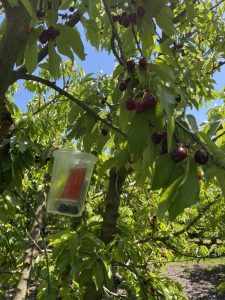
Save insecticides with a short preharvest interval (PHI) for later applications to ensure the fruit is safe for the domestic and export markets as maximum residue limits widely vary among countries.
Follow all label instructions and regulations when using chemical control measures.
Potential Future Alternative Measures Genetic control involves the use of genetic modification techniques, such as gene drive, gene silencing/RNAi and sterile insect technique, to reduce the pest population. However, genetic control of SWD is still in the early stage, and there are no commercially available genetically modified strains of SWD for pest control.
Researchers have identified several potential natural enemies that can be used against SWD. The most potent one is the imported larval parasitoid wasp, Ganaspis brasiliensis of SWD, also found recently in the U.S. The wasp injects its ovipositor and lays an egg inside SWD larvae that are within the fruit. This wasp has shown high efficacy against SWD in various laboratory and greenhouse studies and is now in field trials.
SWD populations in many regions are becoming increasingly resistant to commonly used insecticides due to the continuing reliance on chemical insecticides, highlighting the need for continued research into alternative methods for controlling SWD and for developing effective insecticides against resistant populations. While progress is being made on these fronts, integrated use of available methods, including rotating the insecticide mode of action, is still the effective way to manage SWD to slow the spread of resistance.

